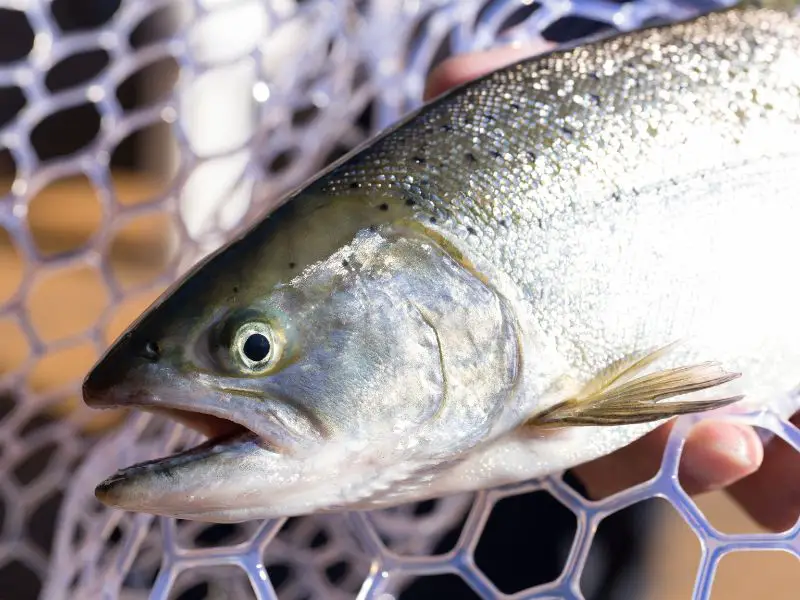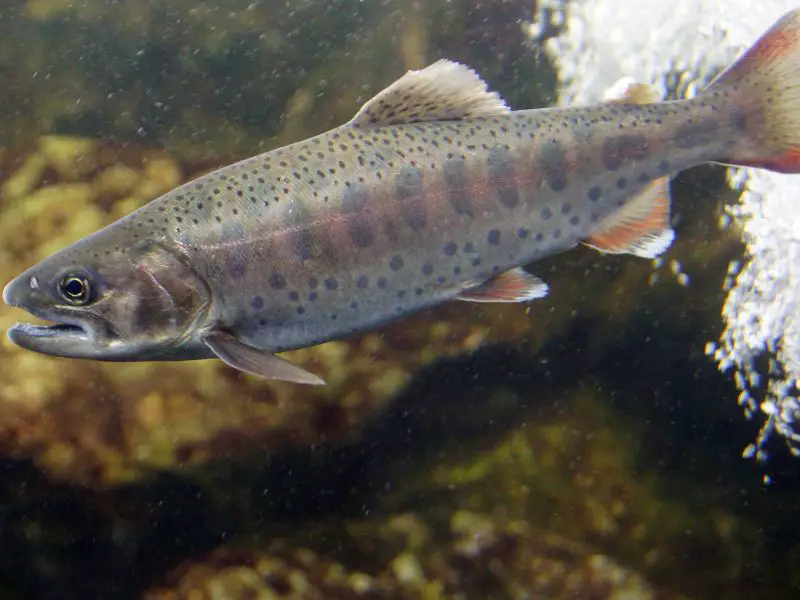This is a continuation of my series of articles covering some of the lesser known species of trout, and trout-like fish.
This article is going to head back to East Asia to look at Oncorhynchus masou, a fish that seems to saddle the definition between a trout and salmons.
What are they called?
Cherry trout are known by many names, but the most common English name is the cherry trout, cherry salmon, and masu salmon.
In Korea they are known as the Sancheon, In Japan, they are known as the Yamane, Amago or Biwa trout. The sea run variant is called the Sakura Masu. In Taiwan, they are known as the Formosan salmon.
Why are they called cherry salmon?
There are two prevailing theories on how their name come to be.
One story goes, that they earned their name because the peak of the cherry salmon runs coincides with that of the cherry blossom season.
Alternatively, some people claim the name comes from the pinkish red breeding coloration of the mature fish.
Are they salmon or trout?
From a purely genetic perspective, their relationship with other species of Pacific salmon is not entirely clear, but some genetic analysis suggests their nearest relatives are Chum, Pink, and Sockeye salmon.
In many ways, they are both salmon and trout. The majority of publications in English consider the species salmon, while the eastern articles I have read seem to use the terms interchangeably. They define the river dwelling population as trout, and the sea run population as Salmon.
Genetically, both the river dwelling and sea run populations are the same fish, think of it like the difference between a rainbow trout and a steelhead. The same fish, but two different lifestyles.
I personally consider them more trout than salmon, and I will explain why. It is widely considered that all pacific salmon die after spawning, while the pacific trout like rainbows and cutthroat usually survive their spawning runs.
Most cherry trout do die after spawning, but not all. Depending on the fishery between 10-15% of the fish survive the spawn. That number is mostly made up of stunted males, but the facts are simple. Like trout, they do not all die after the spawn. So, in my book, this places them more under the definition of a trout than salmon.
What do they look like?
The juvenile cherry trout look very similar to jurvenile rainbow trout of the same age. I certainly can not tell them apart where the two species coexist.
Mature Cherry salmon are silvery fish that grows to about 40cm in length with the largest specimens around 60cm. Their back is dark and their sides are covered with black spots. They have a red tinge along their body that deepens as spawning approaches
There is quite a bit of variation in the appearance of juveniles and landlocked cherry trout. The most common appearance is pale brown, with small dark spots scattered along their backs. They have much more dominant oval, dark brown parr marks than similar size rainbow trout.

Where do cherry trout live?
Cherry trout are native to North East Asia, they can be found along the eastern coastline of the Korean Peninsula, and along the Japanese archipelago including the Russian controlled island of Sakhalin. There is also a relict population above 1500m in the mountains of Taiwan.
Cherry trout prefer clean, cold water where the water temperature is about 2-18°C and rarely exceeding 20°C even in summer.
While living in Korea, I mostly caught cherry trout in small blueline headwater tributaries where the water is cold year-round. They are very rare during the summer in the larger rivers where the water is warmer. In the colder winter months, they do migrate downstream into deeper water.
Cherry trout in Japanese
Japan is one of the strongholds of the cherry trout, but even there the cherry trout population is only a fraction of its original size. Habitat destruction, damming of rivers, and overfishing has annihilated the yearly runs. Historically the salmon runs used to provide widespread employment, with the fishermen landing hundreds of salmon in a season.
Today across much of japan only residue populations of often landlocked cherry trout remain. The best cherry trout fishing in Japan is on the northern island of Hokkaido, while the numbers and size of cherry trout rapidly deteriorate south of Tokyo. Japan has hot summers, and Cherry trout are a cold water fish after all.
There is also a sub species living in the Lake Biwa known as the Biwa trout.
Overall the population in Japan is healthier than in Korea but it is far from a flourishing fishery.
Cherry trout in Korea
Wild populations of cherry trout are endangered in Korea, a combination of overfishing, habitat destruction, dam development has limited their range to only a handful of catchments along the east coast. These wild populations are often supplemented with hatchery raised fish in an effort to save the species.
Populations are likely to be healthier in North Korea due to the colder climate, higher topography, and less development of rural areas. Finding exact information is difficult.
Cherry trout in Russia
Information is scarce regarding the range cherry trout range in the Russian wilderness. The healthiest populations of cherry trout likely occur in the Russian far east as far north as the Kamchatka Peninsula and the Sakhalin islands.
There the largest specimens can still be found with fish up to 70cm in length and weighing 9 kg (20lb). They likely coexist alongside wild populations of rainbow trout in the Kamchatka Peninsula.
Cherry trout in Taiwan
An isolated landlocked population, known as the Formosan landlocked salmon exists in a few mountain streams of sub-tropical Taiwan. The numbers got as low as 200 individuals until the Taiwanese government, started an effective conservation effort that has seen their population rise to a historical high of 12,587.
When do they spawn?
Cherry Salmon begin entering the rivers around May to start their upstream migrations. The main spawning event begins in early October.
The fry lives between the river gravel until they reach about 100mm in size which will trigger an urge to migrate out to sea at about 1 year of age.
How and where to catch them?
Out of the three countries where it is legal to fish for cherry trout, two are currently inaccessible.
I normally will say Japan and Russia offer the most reliable fishing for them. But, due to the current war Russia is rightfully off limits, and Japan still has its borders mostly closed because of corona.
When the borders reopen, I might expand on this section, but currently, South Korea is the only accessible country where it is legal to fish for cherry trout.
In South Korea Cherry trout for the most part are limited to the headwaters, on the east coast of the Gangwon province, requiring a two-three hour drive from Seoul to reach.
While fishing in South Korea does not require a license, quite a lot of the rivers where the cherry trout live are off limits. All fishing is prohibited inside national parks and there are quite a few sanctuaries that also offer protection.
Cherry trout are typically small, and are usually targeted with a 3 or 4wt fly rod. Their feeding preference is nothing special, and the tactics that are used to catch stream rainbow trout work perfectly fine on cherry trout. They even take spinning lures and Rapalas.
If my time in Korea has taught me one thing, is that over the summer months, the tiny cherry trout are certainly not afraid of large dry flies, and when not hiding they will rise to take them with some vigor.
Cherry salmon can be targeted as they migrate up the rivers, but their numbers are few and far between and there can be days between captures. There are also fishing bans in place on some rivers during the man runs.
Summary
For more information about rare or unusual trout breeds, you might be interested in the following articles.


Are trout farmed in thailand. I see them in the market occasionally.
Apparently, they do have trout farms in Thailand. I suspect they will be in the north, in the highlands (around Pai). In that region, there are numerous caves, and the streams that flow through them should be cold enough for trout.
Has anyone thought of introduced them to north America they sound like a good breed to have here
I am not aware of any attempts to stock them outside of Asia. Between rainbow trout and the species of smaller salmon, I do not really see many benefits, other than the novelty of introducing cherry trout to North America. They will either get outcompeted or replace some more vulnerable native species.